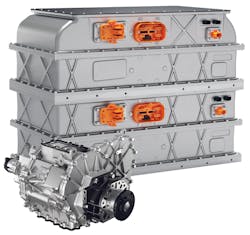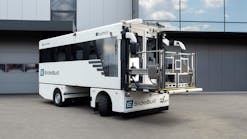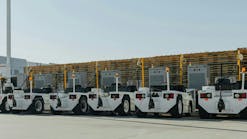Years ago, Powertrain Control Solutions (PCS) found its way to the ground support equipment industry by integrating automotive technology from General Motors (GM) into existing GSE.
PCS has recently waded into the eGSE market with a similar project, converting GSE by adapting the GM electric vehicle drivetrain into airport equipment.
“Our original introduction to the ground support market used a transmission that GM released to the automotive world,” PCS president Dan Boucher recalls. “We customized it and integrated it with the performance and safety features that the ground support world needed.
“With what we’ve done to that, it’s been a success in the industry. We’re doing the same exact thing, just now with an electric driveline.”
PCS debuted its eGSE solution at the International GSE Expo, which is comprised of an electric motor and battery pack produced by GM. The customized version of GM’s powertrain has been built into several GSE units, including a belt-loader, an M1A bag tractor and an MA bag tractor.
“For more than 60 years, GM’s OEM sales business, now GM Powered Solutions, has provided engines, transmissions and other propulsion equipment to companies in marine, industrial, off/on highway and utility markets,” says Tony Brower, GM’s senior manager of OEM sales and engineering. “This strategic collaboration represents an exciting opportunity for GM to extend its commitment to an all-electric future into other industries, enabling companies that utilize ground support equipment to reach their own emissions targets.”
While this project got a head start by utilizing existing electric vehicle technology, PCS had to find a way to get the battery system to fit into GSE units. Engineers reconfigured the layout of GM’s lithium-ion powered cell module assemblies (CMAs) to fit within the footprint provided by a bag tractor or belt-loader.
“The new battery created for the ground support industry uses two production CMAs stacked on top of each other” Boucher says. “It has all the safety features, all of the performance, all of the advanced manufacturing that goes into it.”
PCS engineers customized the motor that’s used in GM’s on-highway vehicles with a component used on all PCS transmissions designed for the GSE industry. According to Boucher, this creates a drop-in solution for customers converting from an internal combustion engine and transmission and allows customers to use the same driveshaft, shifter and parking brake.
“We really tried to make a driveline that would look as common as what they’re using now. But you have all the benefits of the electric drivetrain over the internal combustion engine,” Boucher says. “To the operator, it doesn’t look any different. They know how to operate it. They’re comfortable with it.”
Partnering with GM on this project, allowed for extensive testing of the bag tractors at the automotive manufacturer’s testing facility in Milford, Mich.
“It was a very significant integration project. The testing and the validation was incredibly significant,” Boucher says.
GM’s electric vehicle technology provides charging flexibility.
“These can take as little as 110 or 120V AC charging. It’s slow, but it’s available everywhere,” Boucher says.
“Stepping that up, you can use 240 or 208V and get about 10 percent per hour,” he adds. “Then you still have the option of a Level 3, which is a dedicated high-speed charger on operations that need it.”
The vehicles use the same SAE charging receptacles that electric vehicles use, so no custom charging equipment is required.
“The batteries are also designed to be more than a battery,” Boucher says.
“On many electric GSE vehicles, you have a battery and some high-voltage wiring that goes to the main contactors somewhere on the vehicle,” he explains. “On the on-highway batteries, the main contactors are built inside the pack itself. So, you don’t have any high-voltage wiring containing high-voltage, unless the system has identified that everything is safe to close the contactors and turn on the high-voltage.”
With constant monitoring of different interlock loops and a fireman safety loop, similar to what’s found on on-road electric vehicles, several safety features have been designed to reduce the risk of high-voltage accidents. A battery management system contained inside the pack and another one outside the pack constantly monitors cell voltage, current and state-of-charge to make sure everything is operating within safe limits.
“If there are any issues, it will not allow any systems to engage the high-voltage,” Boucher says.
Because the motor used in these bag tractors and belt-loader provides 200 hp, there are plans to expand the use of the electric drivetrain.
“What we’re anticipating is that this one driveline will really be able to scale across an entire fleet of GSE for a particular airline. They will be able to use this driveline in bag tractors, cargo tractors, pushbacks, catering trucks, lav trucks because it so scalable and so configurable,” Boucher says. “We started with the small equipment, but it’s very scalable, so the next steps for us is to move into the larger equipment.”







